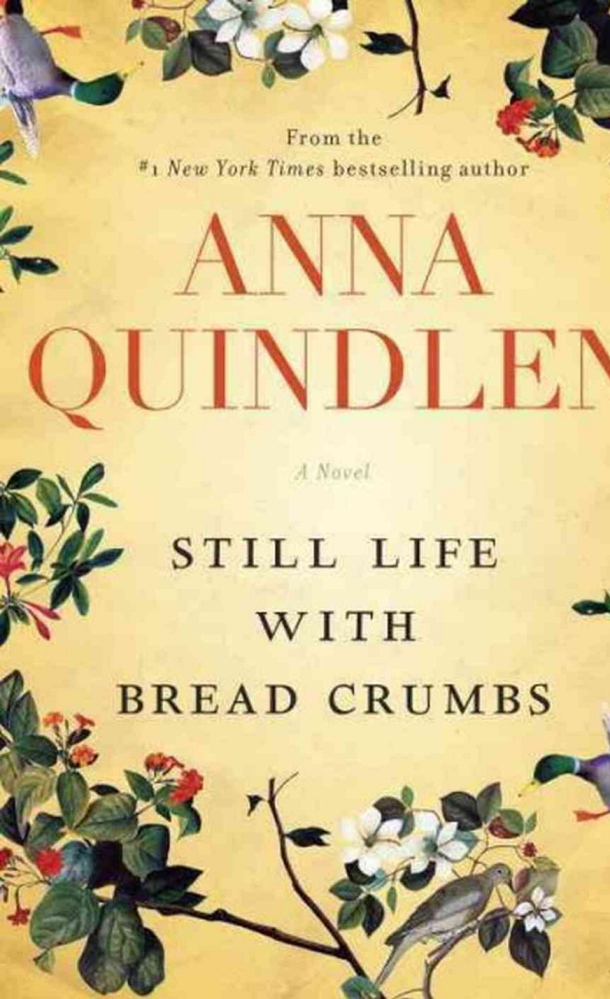The only thing that might have made “Still Life With Bread Crumbs” more enjoyable would have been a summer’s day so I could have read it outside, instead of huddled near a space heater.
It’s the seventh novel from Anna Quindlen, the former New York Times columnist who won the Pulitzer Prize, wrote regularly for Newsweek and published the slender “A Short Guide to a Happy Life,” which has sold more than 1 million copies, many to moms, aunts, grandmothers, family friends and others looking for a little something special to wrap and pair with a check tucked into a graduation card.
She wrote the novel “One True Thing,” turned into the film earning Meryl Streep her 11th Oscar nomination as a dying wife and mother. I could see “Still Life” as a movie, with a superb role for a 60-year-old actress or someone younger but willing to play older such as Annette Bening.
The book takes its title from the most famous photograph ever taken by protagonist Rebecca Winter. It happened years earlier after an exhausting day nursing a toddler with an ear infection and cooking for her husband and his four surprise dinner guests.
She fell asleep on the couch in their Manhattan apartment, awoke still fatigued and angry, grabbed her new camera and clicked away, never sure of the whys.
“Over the years she’d made up a lot of reasons because people didn’t seem to like the arbitrariness of the reality,” Ms. Quindlen writes.
“They also didn’t believe that she’d simply photographed what was already there – a bottle lying on its side with a puddle of olive oil shimmering along its curved lip, a handful of greasy forks glistening in the overhead lights and … a vaguely Flemish composition of dirty wineglasses, stacked plates, the torn ends of two baguettes, and a dish towel singed at one corner by the gas stove.” That was years earlier, though. As the reader meets Rebecca, she’s divorced, renting a ramshackle country cottage while she sublets her New York apartment (she needs the money) and terrified of noises that turn out to be a raccoon in the attic.
When she wavers on the fate of the critter trapped by third-generation roofer Jim Bates, he says, “Sometimes I think city people wind up watching too many Disney films. They confuse real animals with cartoon animals.” She has always been a city person but Bates and others come to shape and define the next chapter in her life. It’s unexpectedly rich, surprising, sorrowful and joyous, with developments she couldn’t see coming and some she could.
In a world where publishers and studios are looking for the next young-adult trilogy with a teen or twenty-something heroine in a post-apocalyptic world, Quindlen isn’t afraid to write about a woman of a certain age and life experiences.
Even if Rebecca’s “before” life is foreign or her monthly bills far richer than the average woman’s – $1,400 for maintenance on her apartment, $1,000 for the cottage – she is relatable to the reader.
So are Quindlen’s astute observations, as when she describes the domestic divide between newlyweds, one of whom wanted a brand-new house while the other wouldn’t mind one with a “black scratchy mark in one corner of the living room that showed the spot where the top of the Christmas tree always grazed the ceiling and left a tattoo of evergreen gum.” Those are the sorts of details every writer and reader lives for.
Although it seems improbable that one tragedy would stay off Rebecca’s radar for as long as it does, it’s still life, with heartaches such as infidelity, illness and death, and, outweighing all else, love when someone least expects but most cherishes it.
Send questions/comments to the editors.



Success. Please wait for the page to reload. If the page does not reload within 5 seconds, please refresh the page.
Enter your email and password to access comments.
Hi, to comment on stories you must . This profile is in addition to your subscription and website login.
Already have a commenting profile? .
Invalid username/password.
Please check your email to confirm and complete your registration.
Only subscribers are eligible to post comments. Please subscribe or login first for digital access. Here’s why.
Use the form below to reset your password. When you've submitted your account email, we will send an email with a reset code.